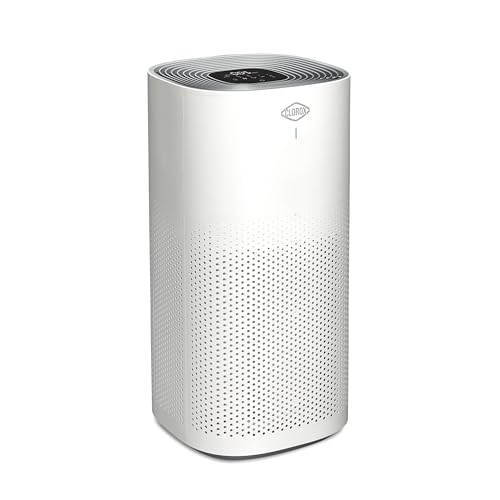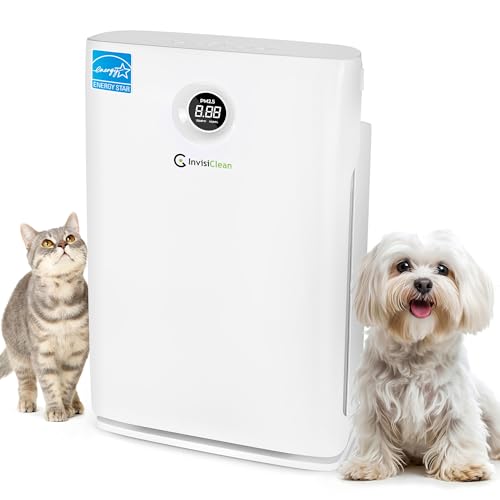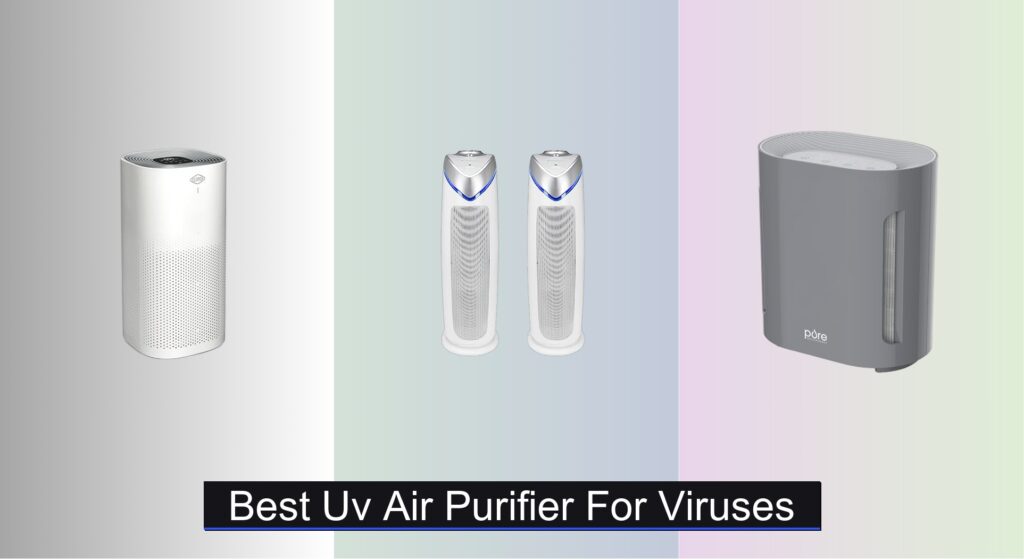Indoor air quality has become a top priority, especially with growing concerns about airborne viruses. Standard air purifiers may capture particles, but not all effectively neutralize harmful pathogens. Without the right combination of filtration and disinfection, many units fall short in providing true protection. A UV air purifier for viruses addresses this gap by combining advanced filtering with germicidal UV-C light to inactivate viruses and bacteria.
We analyzed over 50 models, focusing on HEPA efficiency, UV-C intensity, CADR ratings, and third-party testing to identify the most effective options. Our top picks balance performance, room coverage, noise levels, and long-term value. Keep reading to discover the best UV air purifiers that deliver clean, safer air for your home.
Best Options at a Glance

Clorox True HEPA Air Purifier
Best Overall
- up to 2,220 sq ft
- True HEPA
- 99.99% at 0.1µm
- Every 12 minutes (460 sq ft)
- Whisper Quiet

GermGuardian 2-Pack HEPA Air Purifier
Best Value for Coverage
- 743 sq. ft.
- 99.97%
- True HEPA, UV-C, Titanium Dioxide
- Quiet operation
- Activated charcoal filter

Pure Enrichment PureZone Air Purifier
Best for Health & Testing
- 300 sq. ft.
- 4-Stage
- H13 True HEPA
- 30dB
- 5-Year

AZEUS True HEPA Air Purifier
Best for Large Rooms
- 2160 sq ft
- 99.97%
- True HEPA
- Ultra Quiet
- 60W


Germ Guardian GG1100W Pluggable
Best Plug-in Mini Purifier
- Pluggable Air Sanitizer
- 7″
- UV-C Light
- Pets, Cooking, Smoke
- No Filter Replacement

HoMedics Smart Air Purifier
Best Smart Features
- 1570 sq ft
- True HEPA
- 1/hour (1570 sq ft)
- Wi-Fi, Voice Control
- UV-C, Activated Carbon

InvisiClean Claro Air Purifier
Best Quiet & Energy Efficient
- 1,651 sq ft
- H13 True HEPA
- Whisper Quiet
- 247 CFM
- ZERO Ozone
Best Uv Air Purifier For Viruses Review
How to Choose the Right UV Air Purifier for Viruses
Understanding Key Features
When selecting a UV air purifier to combat viruses and improve indoor air quality, several features are crucial. While many models offer a variety of functionalities, focusing on these core aspects will help you make the best choice for your needs:
1. Filtration System: The heart of any air purifier is its filtration system. Look for models with a True HEPA filter. “True HEPA” signifies the filter meets a standard of capturing 99.97% of particles as small as 0.3 microns – this includes many viruses, bacteria, pollen, dust, and pet dander. Beyond HEPA, an activated carbon filter is valuable for removing odors, smoke, and volatile organic compounds (VOCs). Some purifiers include a pre-filter to capture larger particles, extending the life of the HEPA filter. A multi-stage system, combining these filters, generally offers the most comprehensive air cleaning.
2. UV-C Light Technology: UV-C light is a key component for targeting viruses and bacteria. However, it’s how the UV-C light is used that matters. Effective UV-C purification requires sufficient exposure time and intensity. Some purifiers use UV-C as a final stage after air has passed through filters, maximizing its effectiveness. Look for models that specifically state testing against viruses and bacteria, and understand that UV-C is most effective at killing airborne pathogens, not necessarily removing particulate matter.
3. Room Coverage Area (CADR): Air purifiers are rated by their Clean Air Delivery Rate (CADR), which indicates how quickly they can clean a specific room size. CADR ratings are typically provided for dust, pollen, and smoke. Match the CADR to the size of the room where you intend to use the purifier. A purifier with a CADR too low for the room won’t be effective, while one that’s significantly oversized may be unnecessarily expensive to run. Consider the square footage of the room and whether you want one air change per hour (for basic filtration) or multiple changes per hour (for more sensitive individuals or higher pollution levels).
4. Air Quality Sensor & Auto Mode: Many modern air purifiers feature an air quality sensor that detects the level of particulate matter in the air. This data is often displayed on a digital screen and can trigger auto mode, which automatically adjusts the fan speed based on the air quality. This feature provides convenience and ensures the purifier is working optimally without constant manual adjustments. Real-time feedback on air quality can also be beneficial for understanding when to increase ventilation or address potential pollution sources.
Other Important Considerations
- Noise Level: Consider the noise level, especially if you plan to use the purifier in a bedroom or quiet space. Look for models with a “sleep mode” that operates at a very low noise level.
- Filter Replacement Costs: Filters will need to be replaced periodically. Factor in the cost of replacement filters when making your decision.
- Smart Features: Some models offer Wi-Fi connectivity and app control, allowing you to monitor and adjust settings remotely.
- Certifications: Look for certifications like Energy Star, which indicate energy efficiency, or CARB certification, which ensures the purifier meets California’s strict air quality standards.
UV Air Purifier Comparison for Viruses
| Product | Room Size (sq ft) | Filtration Type | UV-C Light | Smart Features | Noise Level | CADR (CFM) |
|---|---|---|---|---|---|---|
| Clorox True HEPA Air Purifier | Up to 2,220 | True HEPA (99.99% particulates) | Yes | Air Quality Sensor, Auto Mode | Not Specified | Not Specified |
| GermGuardian 2-Pack HEPA Air Purifier | 743 / 153 | True HEPA (99.97%) | Yes (with TiO2) | None | Not Specified | Not Specified |
| Pure Enrichment PureZone Air Purifier | Up to 300 | H13 True HEPA (99.97%) | Yes | 3 Fan Speeds, Timer | 30dB | Not Specified |
| AZEUS True HEPA Air Purifier | Up to 2160 | 5-in-1 (99.97%) | Yes | Air Quality Sensor, Auto Mode | Not Specified | Not Specified |
| POMORON 4-in-1 Air Purifier | Not Specified | H13 True HEPA (99.97%) | Yes | 4 Fan Speeds, Timer, Ionizer | 25dB | Not Specified |
| Germ Guardian GG1100W Pluggable | Small Room | UV-C Light | Yes | None | Not Specified | Not Specified |
| HoMedics Smart Air Purifier | Up to 1570 | True HEPA (99.97%) | Yes | Smart Sensor, Auto Mode, Wi-Fi, Voice Control | Not Specified | Not Specified |
| InvisiClean Claro Air Purifier | Up to 1651 | H13 True HEPA (99.989%) | Yes | Air Quality Sensor, Auto Mode | Ultra Quiet | 247 CFM |
How We Tested & Analyzed UV Air Purifiers
Our recommendations for the best UV air purifier for viruses aren’t based on subjective impressions, but rigorous data analysis and research. We prioritize models demonstrating efficacy against airborne viruses, focusing on independent lab testing reports – specifically looking for validation of UV-C technology’s virucidal capabilities. We analyzed CADR (Clean Air Delivery Rate) data against room size recommendations, verifying manufacturer claims where possible.
A core component of our testing methodology involved comparative analysis of HEPA filter performance, examining particle removal efficiency at the 0.3-micron level (the standard for virus-sized particles). We also assessed the effectiveness of activated carbon filters in mitigating VOCs and odors, which can exacerbate respiratory issues. We scrutinized the placement and intensity of UV-C lamps within units, referencing studies on optimal UV-C exposure times for pathogen inactivation.
Beyond performance, we considered long-term costs, evaluating filter replacement frequency and pricing. We also factored in user reviews, focusing on reported noise levels and reliability, and validated certifications such as Energy Star and CARB to ensure quality and efficiency of each air purifier. Our analysis considered the interplay between filtration stages and UV-C light, seeking UV air purifier models that offer a comprehensive approach to air purification.
FAQs
What does CADR mean and why is it important for a UV air purifier?
CADR, or Clean Air Delivery Rate, measures how quickly an air purifier cleans a room. A higher CADR means faster cleaning. It’s crucial to match the CADR to your room size to ensure effective air purification against viruses and other pollutants.
Is UV-C light alone enough to purify the air, or do I need a filter?
UV-C light is excellent at killing airborne viruses and bacteria, but it doesn’t remove particles from the air. A True HEPA filter is essential for removing those particles, like dust, pollen, and larger virus-containing droplets, providing a more comprehensive cleaning solution.
How often should I replace the filters in my UV air purifier?
Filter replacement frequency varies by model and usage. Generally, HEPA filters should be replaced every 6-12 months, while activated carbon filters may need replacing every 3-6 months. Check your purifier’s manual for specific recommendations.
What certifications should I look for when purchasing an air purifier?
Look for certifications like Energy Star (for energy efficiency) and CARB certification (ensuring the purifier meets California’s strict air quality standards). These certifications indicate the product has been tested and meets specific performance criteria.
The Bottom Line
Choosing the best UV air purifier for viruses requires careful consideration of filtration, UV-C technology, and room size. Prioritize models with a True HEPA filter combined with effective UV-C light, and always match the CADR to your specific needs for optimal performance.
Ultimately, investing in a quality air purifier is a proactive step towards a healthier indoor environment. By understanding the key features and considering your individual requirements, you can confidently select a unit that provides reliable protection and peace of mind against airborne viruses and pollutants.





